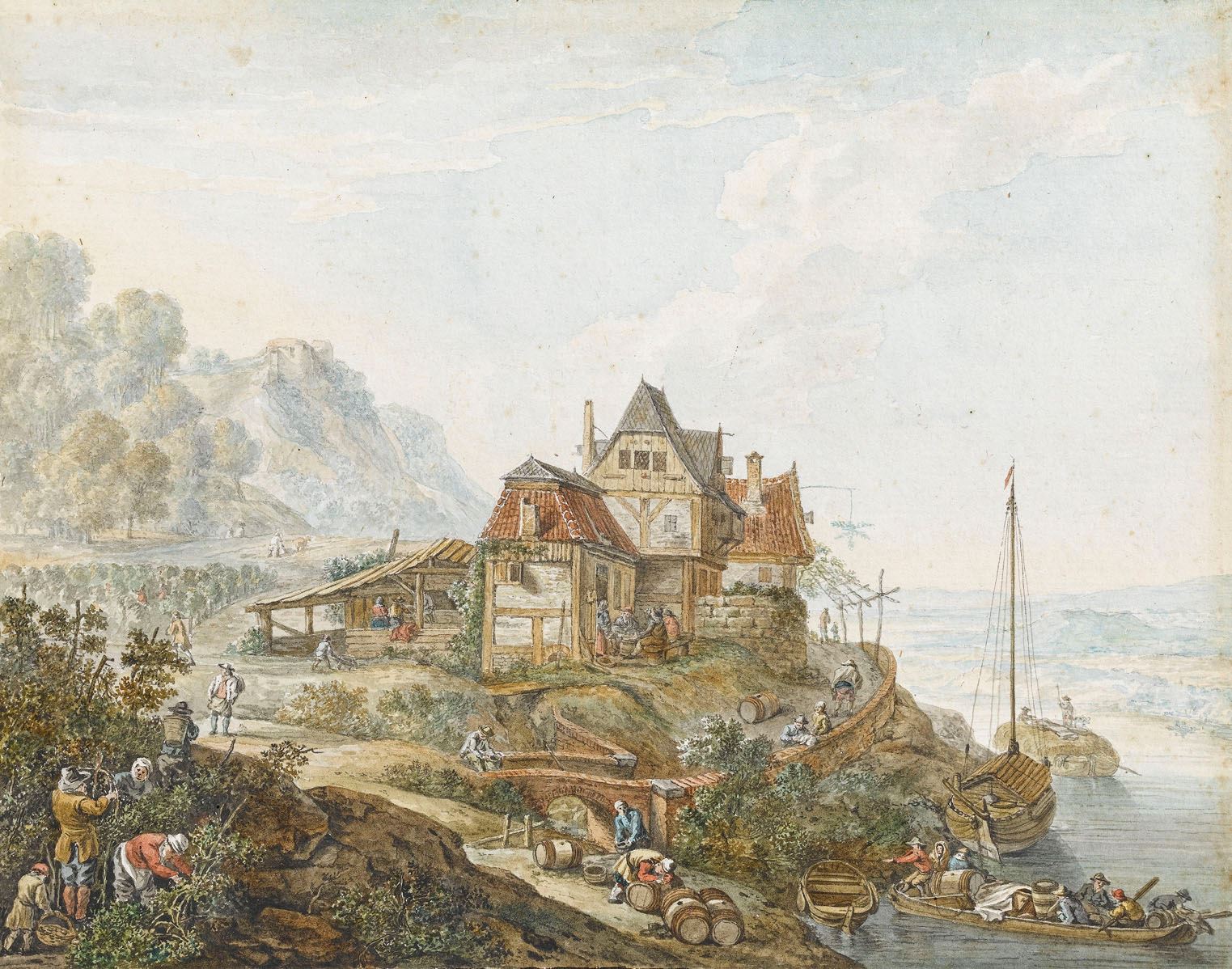Jacob VAN STRIJ
(Dordrecht 1756 - Dordrecht 1815)
A Rhine Landscape with Peasants at Work, after Herman Saftleven
Sold
Watercolour, pen and brown and grey ink, with framing lines in brown ink.
Signed, dated and inscribed Roelofseck: / Herman Saftleven. f. A: Utrecht / Anno 1664. / na het orgeneele het welk berust by den / wel edele Heer Mr Barthout van Slingelandt, vryheer van Slingeland / en Goidschalxoord te dordrecht. door Jacob van Stry 1784 on the verso.
Numbered 7 on the verso.
187 x 235 mm. (7 3/8 x 9 1/4 in.)
Signed, dated and inscribed Roelofseck: / Herman Saftleven. f. A: Utrecht / Anno 1664. / na het orgeneele het welk berust by den / wel edele Heer Mr Barthout van Slingelandt, vryheer van Slingeland / en Goidschalxoord te dordrecht. door Jacob van Stry 1784 on the verso.
Numbered 7 on the verso.
187 x 235 mm. (7 3/8 x 9 1/4 in.)
This watercolour is a fine example of a type of highly finished drawing that Jacob van Strij produced throughout his career. The present sheet is among the relatively few signed and dated drawings by the artist, and was almost certainly executed as an independent work of art. It is a faithful copy of a small oil painting on panel, dated 1664, by the 17th century Dutch artist Herman Saftleven (1609-1685). As the inscription on the verso of the sheet notes, van Strij made the drawing in 1784 from Saftleven’s painting, which was at the time in the collection of M. Barthout van Slingeland, lord of Slingeland and Goidschalxoord, near Dordrecht. Saftleven’s small painting, one of a pair of Rhineland compositions of 1664, appeared with its pendant on the art market in 1999, and is today in a private collection. Saftleven’s painting is signed, dated and inscribed ‘Roelofseck’ on the reverse, and it has been suggested that this may refer to the town of Rolandseck, on the Rhine south of Bonn. Saftleven made numerous trips along the Rhine valley in his lifetime, including one in 1663, the year before the date of the painting.
Like many Dutch artists of the 18th century, Jacob van Strij made a number of elaborate watercolour drawings after the work of earlier Dutch masters, including Cuyp, Jan Both, Jan Wijnants, Meindert Hobbema and Gerard Ter Borch, among others. One such drawing by van Strij, after a pastoral landscape by Nicolaes Berchem, is in the Boijmans Van Beuningen Museum in Rotterdam, and two other watercolours by the artist, copying works by Both and Cuyp, are in the collection of the Amsterdams Historisch Museum. Often, as in the case of the present sheet, van Strij would base his watercolour copies on paintings to be found in local Dordrecht collections.
The stamp on the verso of this drawing is that of a society of amateurs and connoisseurs known as ‘Pictura’, founded in Groningen in 1820 to further the appreciation of Netherlandish art. The society organized several exhibitions, and sold a number of prints and drawings at auction in 1903 and 1906 to raise funds for a permanent home for the society.
Like many Dutch artists of the 18th century, Jacob van Strij made a number of elaborate watercolour drawings after the work of earlier Dutch masters, including Cuyp, Jan Both, Jan Wijnants, Meindert Hobbema and Gerard Ter Borch, among others. One such drawing by van Strij, after a pastoral landscape by Nicolaes Berchem, is in the Boijmans Van Beuningen Museum in Rotterdam, and two other watercolours by the artist, copying works by Both and Cuyp, are in the collection of the Amsterdams Historisch Museum. Often, as in the case of the present sheet, van Strij would base his watercolour copies on paintings to be found in local Dordrecht collections.
The stamp on the verso of this drawing is that of a society of amateurs and connoisseurs known as ‘Pictura’, founded in Groningen in 1820 to further the appreciation of Netherlandish art. The society organized several exhibitions, and sold a number of prints and drawings at auction in 1903 and 1906 to raise funds for a permanent home for the society.
Together with his older brother Abraham, Jacob van Strij was trained in the Dordrecht studio of his father, the decorative painter Leendert van Strij. He completed his studies with Andries Lens in Antwerp, and also drew after the posed model at the city’s Koninklijke Academie voor Schone Kunsten, graduating in 1776. He returned to Dordrecht and there established a successful career. While his brother Abraham specialized in genre scenes, Jacob gained a reputation as a painter of landscapes and pastoral subjects; works which were particularly indebted to the example of the 17th century Dordrecht painter Aelbert Cuyp, whose style he could imitate quite closely. The two brothers often worked in collaboration on mural paintings and decorative wall hangings for private homes in the city. However, Jacob seems to have given up large-scale mural painting around 1800, producing only cabinet pictures from then on. A gifted draughtsman and etcher, Jacob produced a number of fine figure drawings, pastoral subjects and landscapes in watercolour. These were often highly finished works intended for sale to collectors and, like his paintings, were often inspired by the example of the artists of the Dutch Golden Age.
Provenance
The ‘Pictura’ society, Groningen (Lugt 2028), their stamp on the verso.




